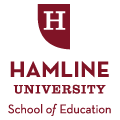Term
Spring 2021
Capstone
Capstone Project
Degree Name
MA-TESOL
Facilitator(s)
Julianne Scullen
Content Expert
Kristina Robertson
Abstract
Research on an equitable education for English Language Learner (ELL) students shows that ELLs underperform on standardized and grade-level assessments as compared to their non-ELL peers. This specific achievement gap persists when ELLs are taught and assessed in only English— a language they are not yet fully proficient in. In order to close this achievement gap, ELL students should be taught content and language simultaneously by teachers who are all experienced in using English language development strategies, while valuing multilingualism as an asset to learning. English-medium schools attempt to meet this goal through the English Language Development (ELD) program models of Pull-out, Push-in, or Co-teaching. However, the specific academic needs of ELLs remain holistically unmet, as they continue to face inequities in accessing all grade-level content in meaningful ways. To understand how to better meet the linguistic needs of ELLs within this setting, the research question of this study is: Which existing English-medium ELL program model (Pull-out, Push-in, Co-teaching) is most effective in meeting the linguistic needs of elementary ELL students, and how can these models be more successful? More quantitative research is still needed to determine the effects of English-medium models on ELL student success. However, the review of literature indicates that each of these models has strong advantages and disadvantages to closing the achievement gap for ELLs. Therefore, the guide designed as the culminating project of this study focuses on utilizing the advantages found within each of the three models within any ELD program. ELL teachers can use this guide to collaborate with mainstream teachers and school administrators to take a holistic, school-wide approach to meeting the academic needs of ELLs. This guide will benefit schools by providing research and strategies for implementing the advantages of all English-medium models, despite a lack of existing research on the topic. The goal of this study is for all educators that serve ELLs to be empowered to meet their unique academic needs within any ELD program model, and for ELL students to experience increased language and academic growth as a result.
Project Type
Guide to an Effective English-medium ELL Program Model
Keywords
ESL/ ELLs, Teachers/ Teaching, English-medium Models, Linguistic Needs
Recommended Citation
Neumann, Molly, "The Advantages of Existing English-Medium Models in Meeting the Linguistic Needs of Elementary ELL Students" (2021). School of Education and Leadership Student Capstone Projects. 641.
https://digitalcommons.hamline.edu/hse_cp/641
dc_type
text
dc_publisher
DigitalCommons@Hamline
dc_format
application/pdf
dc_source
School of Education Student Capstone Projects

